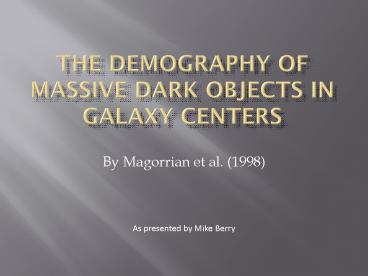The Demography of Massive Dark Objects in Galaxy Centers - PowerPoint PPT Presentation
1 / 15
Title:
The Demography of Massive Dark Objects in Galaxy Centers
Description:
Star clusters of the required mass and size are difficult to construct and maintain ... Y and MDO mass Mo, then find vr and vz using the inclination angle (i) ... – PowerPoint PPT presentation
Number of Views:48
Avg rating:3.0/5.0
Title: The Demography of Massive Dark Objects in Galaxy Centers
1
The Demography of Massive Dark Objects in Galaxy
Centers
- By Magorrian et al. (1998)
As presented by Mike Berry
2
Table of Contents
- Purpose of Paper
- Modeling procedure
- Results for individual galaxies
- MDO distribution
- Conclusions
3
What are Massive Dark Objects? (MDOs)
- Most likely supermassive black holes
- Star clusters of the required mass and size are
difficult to construct and maintain - Fit entire LOS v-dispersion for arbitrary
axisymmetric galaxy models - Crude models predict MDO mass fairly accurately
(M87)
4
Purpose of Paper
- Data from 36 bulges from HST photometry and
decent ground based long-slit spectroscopy - Fit two-integral axisymmetric dynamical models
(not most general but computationally
inexpensive) - Find a statistical distribution of MDOs as a
function of galaxy luminosity - Not meant to unambiguously show that an MDO is
present in any individual galaxy
5
Modeling
- Two-integral approach (cylindrical and
axisymmetric about z-axis) - Assume constant mass to L ratio (Y)
- Makes them flattened spherical isotropic models
- No physics behind why galaxies must be like this
6
Procedure
- Use maximum likelihood to find smooth L-density
that fits observed surface brightness - Large range in density but uncertainty is less
than observed error - Calculate F using Y and MDO mass Mo, then find vr
and vz using the inclination angle (i) - Project luminosity weighted moments to LOS
velocities and convolve with observations - Least squares fit to obtain Mo and Y based on the
likelihood that we see the observed data
7
Individual Galaxy Results
- 4 of 36 galaxies not well fit by models
- Known to have kinematically distinct cores
- By comparison 2 of the other 32 others are known
to have kinematically distinct cores - 3 of 32 are consistent to 1 sigma with Mo0
- 4 of 32 are consistent to 2 sigma with Mo0
- MDO required to produce 2nd moment in galaxies
8
(No Transcript)
9
(No Transcript)
10
(No Transcript)
11
A few interesting galaxies
- HST data for M32, n3115, n3379, n4594
- All are reasonably well fit
- 5 galaxies with nuclear activity or heavy dust (2
models to correct) - Assume all light comes from stars
- Only use photometry gtRmin
- Galaxies with Rmin gt 0 are subject to skepticism
12
(No Transcript)
13
MDO Mass Distribution
- Assume MDO depends on x (xMo/Mb) and other
parameters (w) - Seek most likely set of parameters given data (5
models)
14
(No Transcript)
15
Conclusions
- 32/36 galaxies are well described by 2-integral
axisymmetric models - 28/32 require a substantial MDO
- 97 of galaxies have Mo/Mb 0.05
- Probably a different formation history for
galaxies without a MDO - 2-integral models are not the most generic but
fits agree reasonably well with previous data































